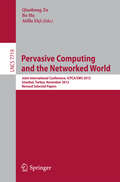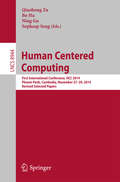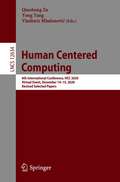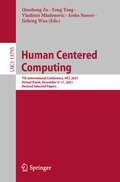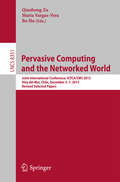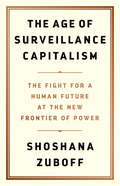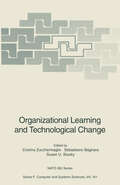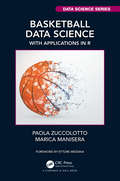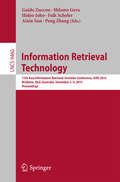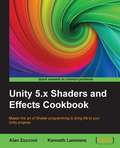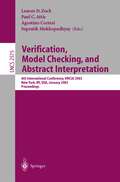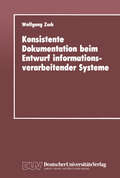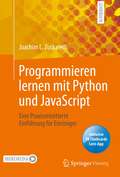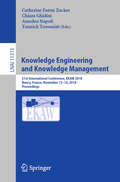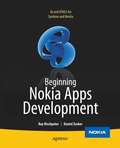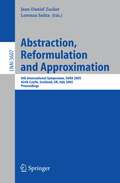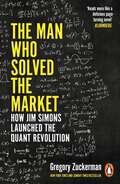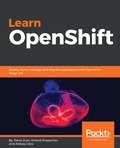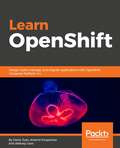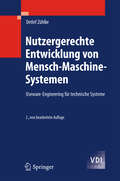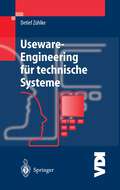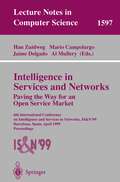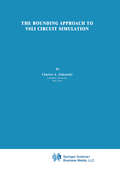- Table View
- List View
Pervasive Computing and the Networked World: Joint International Conference, ICPCA-SWS 2012, Istanbul, Turkey, November 28-30, 2012, Revised Selected Papers (Lecture Notes in Computer Science #7719)
by Qiaohong Zu Bo Hu Atilla ElciThis book constitutes the refereed post-proceedings of the Joint International Conference on Pervasive Computing and the Networked World, ICPCA-SWS 2012, held in Istanbul, Turkey, in November 2012. This conference is a merger of the 7th International Conference on Pervasive Computing and Applications (ICPCA) and the 4th Symposium on Web Society (SWS). The 53 revised full papers and 26 short papers presented were carefully reviewed and selected from 143 submissions. The papers cover a wide range of topics from different research communities such as computer science, sociology and psychology and explore both theoretical and practical issues in and around the emerging computing paradigms, e.g., pervasive collaboration, collaborative business, and networked societies. They highlight the unique characteristics of the "everywhere" computing paradigm and promote the awareness of its potential social and psychological consequences.
Human Centered Computing: First International Conference, HCC 2014, Phnom Penh, Cambodia, November 27-29, 2014, Revised Selected Papers (Lecture Notes in Computer Science #8944)
by Qiaohong Zu Bo Hu Ning Gu Sopheap SengThis book constitutes revised selected papers from the refereed proceedings of the First Human Centered Computing Conference, HCC 2014, that consolidated and further develops the successful ICPCA/SWS conferences on Pervasive Computing and the Networked World. The 54 full papers and 30 short papers presented in this volume were carefully reviewed and selected from 152 submissions. These proceedings present research papers investigating into a variety of aspects towards human centric intelligent societies. They cover the categories: infrastructure and devices; service and solution; data and knowledge; and community.
Human Centered Computing: 6th International Conference, HCC 2020, Virtual Event, December 14–15, 2020, Revised Selected Papers (Lecture Notes in Computer Science #12634)
by Qiaohong Zu Yong Tang Vladimir MladenovićThis book constitutes thoroughly reviewed, revised and selected papers from the 6th International Conference on Human Centered Computing, HCC 2020, held in virtually, due to COVID- 19, in December 2020. The 28 full and 20 short papers presented in this volume were carefully reviewed and selected from a total of 133 submissions.The conference focuses on the following three main themes as follows: Data such as Data Visualization, Big Data, Data Security, Hyper connectivity such as Internet of Things, Cloud Computing, Mobile Network and Collaboration such as Collective Intelligence, Peer Production, Context Awareness and much more.
Human Centered Computing: 7th International Conference, HCC 2021, Virtual Event, December 9–11, 2021, Revised Selected Papers (Lecture Notes in Computer Science #13795)
by Qiaohong Zu Yong Tang Vladimir Mladenovic Aisha Naseer Jizheng WanThis book constitutes thoroughly reviewed, revised and selected papers from the 7th International Conference on Human Centered Computing, HCC 2021, held in virtually, due to COVID- 19, in December 2021. The 18 full and 9 short papers presented in this volume were carefully reviewed and selected from a total of 68 submissions. The conference focuses on the following three main themes as follows: Data such as Data Visualization, Big Data, Data Security, Hyper connectivity such as Internet of Things, Cloud Computing, Mobile Network and Collaboration such as Collective Intelligence, Peer Production, Context Awareness and much more.
Pervasive Computing and the Networked World: Joint International Conference, ICPCA/SWS 2013, Vina del Mar, Chile, December 5-7, 2013. Revised Selected Papers (Lecture Notes in Computer Science #8351)
by Qiaohong Zu Maria Vargas-Vera Bo HuThis book constitutes the thoroughly refereed post-conference proceedings of the Joint International Conference on Pervasive Computing and Web Society, ICPCA/SWS 2013, held in Vina de Mar, Chile, in December 2013. The 56 revised full papers presented together with 29 poster papers were carefully reviewed and selected from 156 submissions. The papers are organized in topical sections on infrastructure and devices; service and solution; data and knowledge; as well as community.
The Age of Surveillance Capitalism: The Fight for a Human Future at the New Frontier of Power
by Shoshana ZuboffThe challenges to humanity posed by the digital future, the first detailed examination of the unprecedented form of power called "surveillance capitalism," and the quest by powerful corporations to predict and control our behavior.In this masterwork of original thinking and research, Shoshana Zuboff provides startling insights into the phenomenon that she has named surveillance capitalism. The stakes could not be higher: a global architecture of behavior modification threatens human nature in the twenty-first century just as industrial capitalism disfigured the natural world in the twentieth.Zuboff vividly brings to life the consequences as surveillance capitalism advances from Silicon Valley into every economic sector. Vast wealth and power are accumulated in ominous new "behavioral futures markets," where predictions about our behavior are bought and sold, and the production of goods and services is subordinated to a new "means of behavioral modification."The threat has shifted from a totalitarian Big Brother state to a ubiquitous digital architecture: a "Big Other" operating in the interests of surveillance capital. Here is the crucible of an unprecedented form of power marked by extreme concentrations of knowledge and free from democratic oversight. Zuboff's comprehensive and moving analysis lays bare the threats to twenty-first century society: a controlled "hive" of total connection that seduces with promises of total certainty for maximum profit--at the expense of democracy, freedom, and our human future.With little resistance from law or society, surveillance capitalism is on the verge of dominating the social order and shaping the digital future--if we let it.
Organizational Learning and Technological Change (NATO ASI Subseries F: #141)
by Cristina Zucchermaglio Sebastiano Bagnara Susan U. StuckyWhat the Book Is About This book is about the problem of organizational learning, that is the analysis of organizations conceived as learning systems. In order to survive in a period of a rapid change, organizations must innovate and than to develop and exploit their abilities to learn. The most innovative organizations are those that can respond with great efficiency to internal and external changes. They respond to and generate technological change by acting as effective learning systems. They maximize the learning potential of ongoing and "normal" work activities. The organizational structure and the technology allow members to learn while the organizations itself learns from its members. So organizations reach high levels of innovation when structured to take advantage of the social, distributed, participative, situated processes of learning developed by its members in interaction with the technological environment. Organizations should consider learning as an explicit "productive" objective. They must create integrated learning mechanisms, that encompass technological tools, reward and incentive systems, human resource practices, belief systems, access to information, communication and mobility patterns, performance appraisal systems, organizational practices and structures. The design of efficient learning organizations requires cognitive, technological and social analyses. All the computer-based technologies (e. g. office automation, communication and group decision support) not only those devoted to and used in training activities, have to be considered as tools for organizational learning and innovation.
Basketball Data Science: With Applications in R (Chapman & Hall/CRC Data Science Series)
by Paola Zuccolotto Marica ManiseraUsing data from one season of NBA games, Basketball Data Science: With Applications in R is the perfect book for anyone interested in learning and applying data analytics in basketball. Whether assessing the spatial performance of an MBA player&’s shots or doing an analysis of the impact of high pressure game situations on the probability of scoring, this book discusses a variety of case studies and hands-on examples using a custom R package. The codes are supplied so readers can reproduce the analyses themselves or create their own. Assuming a basic statistical knowledge, Basketball Data Science with R is suitable for students, technicians, coaches, data analysts and applied researchers. Features: · One of the first books to provide statistical and data mining methods for the growing field of analytics in basketball. · Presents tools for modelling graphs and figures to visualize the data. · Includes real world case studies and examples, such as estimations of scoring probability using the Golden State Warriors as a test case. · Provides the source code and data so readers can do their own analyses on NBA teams and players.
Basketball Data Science: With Applications in R (Chapman & Hall/CRC Data Science Series)
by Paola Zuccolotto Marica ManiseraUsing data from one season of NBA games, Basketball Data Science: With Applications in R is the perfect book for anyone interested in learning and applying data analytics in basketball. Whether assessing the spatial performance of an MBA player&’s shots or doing an analysis of the impact of high pressure game situations on the probability of scoring, this book discusses a variety of case studies and hands-on examples using a custom R package. The codes are supplied so readers can reproduce the analyses themselves or create their own. Assuming a basic statistical knowledge, Basketball Data Science with R is suitable for students, technicians, coaches, data analysts and applied researchers. Features: · One of the first books to provide statistical and data mining methods for the growing field of analytics in basketball. · Presents tools for modelling graphs and figures to visualize the data. · Includes real world case studies and examples, such as estimations of scoring probability using the Golden State Warriors as a test case. · Provides the source code and data so readers can do their own analyses on NBA teams and players.
Information Retrieval Technology: 11th Asia Information Retrieval Societies Conference, AIRS 2015, Brisbane, QLD, Australia, December 2-4, 2015. Proceedings (Lecture Notes in Computer Science #9460)
by Guido Zuccon Shlomo Geva Hideo Joho Falk Scholer Aixin Sun Peng ZhangThis book constitutes the refereed proceedings of the 11th Information Retrieval Societies Conference, AIRS 2015, held in Brisbane, QLD, Australia, in December 2015. The 29 full papers presented together with 11 short and demonstration papers, and the abstracts of 2 keynote lectures were carefully reviewed and selected from 92 submissions. The final programme of AIRS 2015 is divided in 10 tracks: Efficiency, Graphs, Knowledge Bases and Taxonomies, Recommendation, Twitter and Social Media, Web Search, Text Processing, Understanding and Categorization, Topics and Models, Clustering, Evaluation, and Social Media and Recommendation.
Verification, Model Checking, and Abstract Interpretation: 4th International Conference, VMCAI 2003, New York, NY, USA, January 9-11, 2003, Proceedings (Lecture Notes in Computer Science #2575)
by Lenore D. Zuck Paul D. Attie Agostino Cortesi Supratik MukhopadhyayThis volume contains the proceedings of the 4th International Conference on Veri?cation, Model Checking, and Abstract Interpretation (VMCAI 2003), held in New York city, January 9–11, 2003. The purpose of VMCAI was to provide a forum for researchers from three communities—Veri?cation, Model Checking, and Abstract Interpretation—that will facilitate interaction, cross-fertilization, and the advance of hybrid methods that combine the three areas. With the g- wingneedforformaltoolstoreasonaboutcomplex,in?nite-state,andembedded systems, such hybrid methods are bound to be of great importance. Topics covered by VMCAI include program veri?cation, static analysis te- niques, model checking, program certi?cation, type systems, abstract domains, debugging techniques, compiler optimization, embedded systems, and formal analysis of security protocols. VMCAI 2003 was the fourth VMCAI meeting. The previous three were held as workshops (Port Je?erson 1997, Pisa 1998, and Venice 2002). It is the success of the last meeting, and the wide response it generated, that made it clear the time had come to make it an annual conference.
Konsistente Dokumentation beim Entwurf informationsverarbeitender Systeme
by Wolfgang ZuckDiese Arbeit über die konsistente Dokumentation beim Entwurf informationsverar beitender Systeme entstand in den Jahren 1984 bis 1990 während meiner Tätigkeit als wissenschaftlicher Mitarbeiter am Lehrstuhl für Digitale Systeme der Universität Kaiserslautern. Sie wurde vom Fachbereich Elektrotechnik der Universität Kaisers lautern als Dissertation zur Verleihung des akademischen Grades Dr.-Ing. genehmigt Mein Dank gilt in erster Linie Herm Prof. Dr.-Ing. Siegfried Wendt, der nicht nur die Anregung zu dieser Arbeit gab, sondern auch in seiner Arbeitsgruppe das Umfeld bereitstellte und die Unterstützung gewährte, ohne die diese Arbeit nicht hätte ent stehen können. Seine zahlreichen Anregungen trugen wesentlich zur Verbesserung der Arbeit bei. Herm Prof. Dr. Jürgen Nehmer vom Fachbereich Informatik der Universität Kaisers lautern danke ich für die Übernahme des Koreferats und die gründliche Durchsicht der Arbeit. Dank schulde ich auch der Firma SIEMENS, besonders Herrn Dr.-Ing. Dietrich Klugmann und seiner Abteilung (ZFE IS SOF 1), die sowohl durch großzügige Unterstützung der Arbeitsgruppe als auch durch fachliche Kooperation zum Gelingen der Arbeit beitrugen.
Programmieren lernen mit Python und JavaScript: Eine praxisorientierte Einführung für Einsteiger
by Joachim L. ZuckarelliOb auf dem Computer, Tablet, Handy, im Auto oder in der Kaffeemaschine – Computerprogramme bestimmen unseren Alltag. Software wird immer wichtiger, kaum noch etwas funktioniert ohne die geheimnisvolle Macht der Algorithmen. Aber wie funktionieren Programme? Und wie entwickelt man sie? Dieses Buch vermittelt Ihnen anschaulich das Einmaleins des Programmierens. Anhand von Alltagsbeispielen lernen Sie zunächst die Grundkonzepte des Programmierens kennen, die in allen Programmiersprachen ähnlich sind. Auf Basis dieser Grundideen erlernen Sie dann auf systematische Weise und mit vielen praktischen Übungen zwei populäre und sehr nützliche Programmiersprachen, Python und JavaScript, die Sie für ein breites Spektrum an unterschiedlichen Aufgaben einsetzen können.Das Buch richtet sich an Programmieranfänger aller Altersklassen (vom Schüler bis zum Berufstätigen), die bisher keinerlei Programmiererfahrung besitzen.Zusätzliche Fragen per App: Laden Sie die Springer Nature Flashcards-App kostenlos herunter und nutzen Sie exklusives Zusatzmaterial als Printbuchkäufer, um Ihr Wissen zu prüfen.
Knowledge Engineering and Knowledge Management: 21st International Conference, EKAW 2018, Nancy, France, November 12-16, 2018, Proceedings (Lecture Notes in Computer Science #11313)
by Catherine Faron Zucker Chiara Ghidini Amedeo Napoli Yannick ToussaintThis book constitutes the refereed proceedings of the 21th International Conference on Knowledge Engineering and Knowledge Management, EKAW 2018, held in Nancy, France, in November 2018. The 36 full papers presented were carefully reviewed and selected from 104 submissions. The papers cover all aspects of eliciting, acquiring, modeling, and managing knowledge, the construction of knowledge-intensive systems and services for the Semantic Web, knowledge management, e-business, natural language processing, intelligent information integration, personal digital assistance systems, and a variety of other related topics. A special focus was on "Knowledge and AI", i.e. papers describing algorithms, tools, methodologies, and applications that exploit the interplay between knowledge and Artificial Intelligence techniques, with a special emphasis on knowledge discovery.
Beginning Nokia Apps Development: Qt and HTML5 for Symbian and MeeGo
by Daniel Zucker Ray RischpaterWhile media buzz regularly circulates around iPhone and Android, Nokia still leads the pack in terms of world market share. Symbian, for instance, remains the most widely used mobile operating system. With Nokia's open development platform, the opportunities available for mobile developers to target this vastly popular operating system are abundant and clear. Use Qt to target both platforms: Symbian, the most widely used mobile operating system in the world, as well as MeeGo, the Intel/Nokia platform for mobile devices. Develop HTML5 applications for both Symbian and MeeGo platforms that will run with little modification on other mobile platforms. Novice developers learn the basics of Qt with a mobile slant, giving them the ability to target both desktop and mobile platforms.
Abstraction, Reformulation and Approximation: 6th International Symposium, SARA 2005, Airth Castle, Scotland, UK, July 26-29, 2005, Proceedings (Lecture Notes in Computer Science #3607)
by Jean-Daniel Zucker Lorenza SaittaThe Man Who Solved the Market: How Jim Simons Launched the Quant Revolution SHORTLISTED FOR THE FT & MCKINSEY BUSINESS BOOK OF THE YEAR AWARD 2019
by Gregory ZuckermanSHORTLISTED FOR THE FT AND MCKINSEY BUSINESS BOOK OF THE YEAR AWARD 2019'Reads more like a delicious page-turning novel...Put it on your holiday gift list for your favourite hedge-fund honcho' BloombergJim Simons is the greatest moneymaker in modern financial history. His record bests those of legendary investors, including Warren Buffett, George Soros and Ray Dalio. Yet Simons and his strategies are shrouded in mystery. The financial industry has long craved a look inside Simons's secretive hedge fund, Renaissance Technologies and veteran Wall Street Journal reporter Gregory Zuckerman delivers the goods. After a legendary career as a mathematician and a stint breaking Soviet codes, Simons set out to conquer financial markets with a radical approach. Simons hired physicists, mathematicians and computer scientists - most of whom knew little about finance - to amass piles of data and build algorithms hunting for the deeply hidden patterns in global markets. Experts scoffed, but Simons and his colleagues became some of the richest in the world, their strategy of creating mathematical models and crunching data embraced by almost every industry. As Renaissance became a major player in the financial world, its executives began exerting influence on other areas. Simons became a major force in scientific research, education and Democratic politics, funding Hilary Clinton's presidential campaign. While senior executive Robert Mercer is more responsible than anyone else for the Trump presidency, placing Steve Bannon in the campaign, funding Trump's victorious 2016 effort and backing alt-right publication Breitbart. Mercer also impacted the success of the Brexit campaign. For all his prescience, Simons failed to anticipate how Mercer's activity would impact his firm and the world. In this fast-paced narrative, Zuckerman examines how Simons launched a quantitative revolution on Wall Street, and reveals the impact that Simons, the quiet billionaire king of the quants, has had on worlds well beyond finance.
Learn OpenShift: Deploy, Build, Manage, And Migrate Applications With Openshift Origin 3. 9
by Denis ZuevThese days, containers and container management are two of the most important software delivery technologies. This book gives you knowledge and hands-on experience to design, build, and operate OpenShift Origin and its underlying software and services not only in the lab, but in production environments as well.
Learn OpenShift: Deploy, build, manage, and migrate applications with OpenShift Origin 3.9
by Denis Zuev Artemii Kropachev Aleksey UsovGain hands-on experience of installing OpenShift Origin 3.9 in a production configuration and managing applications using the platform you built Key Features Gain hands-on experience of working with Kubernetes and Docker Learn how to deploy and manage applications in OpenShift Get a practical approach to managing applications on a cloud-based platform Explore multi-site and HA architectures of OpenShift for production Book Description Docker containers transform application delivery technologies to make them faster and more reproducible, and to reduce the amount of time wasted on configuration. Managing Docker containers in the multi-node or multi-datacenter environment is a big challenge, which is why container management platforms are required. OpenShift is a new generation of container management platforms built on top of both Docker and Kubernetes. It brings additional functionality to the table, something that is lacking in Kubernetes. This new functionality significantly helps software development teams to bring software development processes to a whole new level. In this book, we'll start by explaining the container architecture, Docker, and CRI-O overviews. Then, we'll look at container orchestration and Kubernetes. We'll cover OpenShift installation, and its basic and advanced components. Moving on, we'll deep dive into concepts such as deploying application OpenShift. You'll learn how to set up an end-to-end delivery pipeline while working with applications in OpenShift as a developer or DevOps. Finally, you'll discover how to properly design OpenShift in production environments. This book gives you hands-on experience of designing, building, and operating OpenShift Origin 3.9, as well as building new applications or migrating existing applications to OpenShift. What you will learn Understand the core concepts behind containers and container orchestration tools Understand Docker, Kubernetes, and OpenShift, and their relation to CRI-O Install and work with Kubernetes and OpenShift Understand how to work with persistent storage in OpenShift Understand basic and advanced components of OpenShift, including security and networking Manage deployment strategies and application's migration in OpenShift Understand and design OpenShift high availability Who this book is for The book is for system administrators, DevOps engineers, solutions architects, or any stakeholder who wants to understand the concept and business value of OpenShift.
Learn OpenShift: Deploy, build, manage, and migrate applications with OpenShift Origin 3.9
by Denis Zuev Artemii Kropachev Aleksey UsovGain hands-on experience of installing OpenShift Origin 3.9 in a production configuration and managing applications using the platform you built Key Features Gain hands-on experience of working with Kubernetes and Docker Learn how to deploy and manage applications in OpenShift Get a practical approach to managing applications on a cloud-based platform Explore multi-site and HA architectures of OpenShift for production Book Description Docker containers transform application delivery technologies to make them faster and more reproducible, and to reduce the amount of time wasted on configuration. Managing Docker containers in the multi-node or multi-datacenter environment is a big challenge, which is why container management platforms are required. OpenShift is a new generation of container management platforms built on top of both Docker and Kubernetes. It brings additional functionality to the table, something that is lacking in Kubernetes. This new functionality significantly helps software development teams to bring software development processes to a whole new level. In this book, we'll start by explaining the container architecture, Docker, and CRI-O overviews. Then, we'll look at container orchestration and Kubernetes. We'll cover OpenShift installation, and its basic and advanced components. Moving on, we'll deep dive into concepts such as deploying application OpenShift. You'll learn how to set up an end-to-end delivery pipeline while working with applications in OpenShift as a developer or DevOps. Finally, you'll discover how to properly design OpenShift in production environments. This book gives you hands-on experience of designing, building, and operating OpenShift Origin 3.9, as well as building new applications or migrating existing applications to OpenShift. What you will learn Understand the core concepts behind containers and container orchestration tools Understand Docker, Kubernetes, and OpenShift, and their relation to CRI-O Install and work with Kubernetes and OpenShift Understand how to work with persistent storage in OpenShift Understand basic and advanced components of OpenShift, including security and networking Manage deployment strategies and application's migration in OpenShift Understand and design OpenShift high availability Who this book is for The book is for system administrators, DevOps engineers, solutions architects, or any stakeholder who wants to understand the concept and business value of OpenShift.
Nutzergerechte Entwicklung von Mensch-Maschine-Systemen: Useware-Engineering für technische Systeme (VDI-Buch)
by Detlef ZühlkeDas Buch gibt Entwicklern einen Leitfaden zur nutzergerechten Gestaltung von Mensch-Maschine-Systemen an die Hand. Dabei werden die besonderen Gestaltungsprobleme von Useware-Systemen für internationale Märkte ebenso behandelt wie die Auswahl von Entwicklungstools, Normen und Richtlinien sowie grundlegende Gestaltungsregeln. Wichtige Neuerungen, etwa die modellbasierte Entwicklung von Benutzungsschnittstellen oder zukünftige Interaktionsformen, werden in der Neuauflage anhand von Gestaltungsbeispielen vorgestellt.
Useware-Engineering für technische Systeme (VDI-Buch)
by Detlef ZühlkeMit dem Begriff Useware ist eine Fokussierung der Technikgestaltung auf menschliche Fähigkeiten und Bedürfnisse an der Mensch-Maschine-Schnittstelle verbunden. Das Buch hilft Entwicklern in der Industrie und Forschung mit praktisch orientierten Beispielen für Gestaltungslösungen. Eine kurze Erläuterung der menschlichen Fähigkeiten erhöht das Verständnis für die Vorgehensweise bei der Gestaltung komplexer Useware-Systeme, die detailliert dargestellt wird.
Intelligence in Services and Networks. Paving the Way for an Open Service Market: 6th International Conference on Intelligence and Services in Networks, IS&N'99, Barcelona, Spain, April 27-29, 1999, Proceedings (Lecture Notes in Computer Science #1597)
by Han Zuidweg Mario Campolargo Jaime Delgado Al MulleryPaving the Way for an Open Service Market We live in an age when powerful communications technology is becoming available to everyone. From our home we can send and receive not only analogue voice, but also growing volumes of digital information and even intelligence in the form of agents. We are becoming increasingly mobile and are expecting the same level of connectivity in the home, in the office, and on the road. The regulatory and commercial environment in which we communicate is changing. The telecommunications market is becoming increasingly competitive. The Internet is erasing the borders between information technology and telecommunications. And the way we do business is ever more dominated by electronic exchanges of information. Is our technology ready for the open market of networks and services? Can we manage the growing complexity of computing and telecommunications technology and place it at the service of the people? The challenge for the research community is to develop the tools and techniques that will ultimately bring the full power of communications and information to everyone, in a way that everyone can easily use. The Sixth International Conference on Intelligence in Services and Networks (IS&N’99) is all about technology for paving the way to the open services market. Since the first IS&N conference in 1992 the focus of the IS&N program has continually shifted. We see existing technologies maturing while new ones emerge, but the bottom line has always been putting technology at the service of the people.
The Bounding Approach to VLSI Circuit Simulation (The Springer International Series in Engineering and Computer Science #17)
by C.A. ZukowskiThis book proposes a new approach to circuit simulation that is still in its infancy. The reason for publishing this work as a monograph at this time is to quickly distribute these ideas to the research community for further study. The book is based on a doctoral dissertation undertaken at MIT between 1982 and 1985. In 1982 the author joined a research group that was applying bounding techniques to simple VLSI timing analysis models. The conviction that bounding analysis could also be successfully applied to sophisticated digital MOS circuit models led to the research presented here. Acknowledgments 'me author would like to acknowledge many helpful discussions and much support from his research group at MIT, including Lance Glasser, John Wyatt, Jr. , and Paul Penfield, Jr. Many others have also contributed to this work in some way, including Albert Ruchli, Mark Horowitz, Rich Zippel, Chtis Terman, Jacob White, Mark Matson, Bob Armstrong, Steve McCormick, Cyrus Bamji, John Wroclawski, Omar Wing, Gary Dare, Paul Bassett, and Rick LaMaire. The author would like to give special thanks to his wife, Deborra, for her support and many contributions to the presentation of this research. The author would also like to thank his parents for their encouragement, and IBM for its financial support of t,I-Jis project through a graduate fellowship. THE BOUNDING APPROACH TO VLSI CIRCUIT SIMULATION 1. INTRODUCTION The VLSI revolution of the 1970's has created a need for new circuit analysis techniques.
